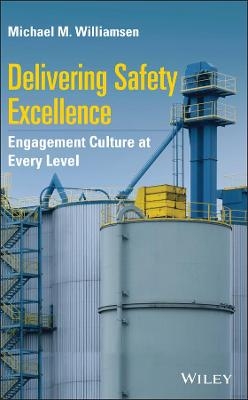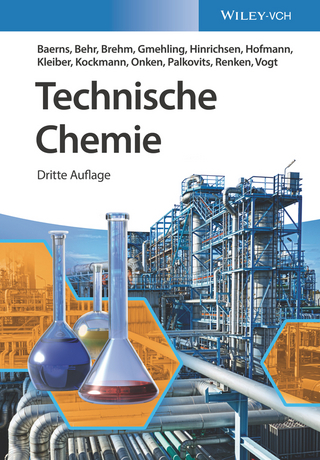
Delivering Safety Excellence
John Wiley & Sons Inc (Verlag)
978-1-119-77213-2 (ISBN)
Delivering Safety Excellence: Engagement Culture At Every Level provides an in-depth and practical overview of how to energize frontline employees, supervisors, managers, and leaders to overcome and solve regularly occurring safety concerns. The book teaches readers how to resolve dysfunctional safety cultures by engaging employees at all levels. This cross functional engagement culture regularly builds safe and effective working practices that eliminate regulatory, financial, and personal risk shortfalls while encouraging profitability and efficiency.
The distinguished author shows how culture improvement processes and models can be utilized to improve the performance all across an organization. The material is presented in dialogue format using case studies to highlight the relationship between the concepts discussed and their application in the real world.
You’ll discover how to implement real solutions in industries of all types and in organizations of all sizes using practical and concrete strategies tested by the author in regions and varying cultures around the world. Readers will also benefit from the inclusion of:
A thorough introduction to rapidly resolving the many common deficiencies in safety culture, including scarce regulatory and cultural materials and a lack of support, trust, and credibility for safety officers
Practical discussions of how urgency can obstruct a consistent culture of safety, performance, and prudence
Explorations of behavior-based safety, the injury plateau, the Occupational Health and Safety Act, and a dynamic model of safety weaknesses that lead to injuries
Perfect for safety officers at all levels of organizations of any size, Delivering Safety Excellence: Engagement Culture At Every Level will also earn a place in the libraries of executives, managers, leaders, supervisors, and employees who seek a one-stop reference for how to build a safe and profitable company.
Michael M Williamsen, PhD, has worked as a turnaround specialist with a number of small, medium and large organizations throughout the world that were in trouble in one or more of their functionalities. Dr. Williamsen started and led a global consulting business of culture change excellence that was subsequently purchased and used globally by a global fortune 50 manufacturer. Dr. Williamsen has been published in the Journal of Safety Professionals and has published 250+ short blog articles which were edited and approved by the parent organizations. For more than a decade Dr. Williamsen has been a featured speaker at the annual American Society of Safety Professionals (ASSP) safety conference, regional safety society conferences, the ASSP Middle East Chapter safety conferences and any number of other company and industry conferences.
Acknowledgements xi
Author Biography xiii
List of Figures xv
Preface xix
Prologue xxi
Introduction xxv
Part I 1
1 The Funeral 3
Notes 10
2 No Support for Safety 11
3 The Tyranny of the Urgent 15
4 No Pay for Safety 21
Note 24
5 Weak Culture Miseries 25
6 Injury Plateau 27
Limitations of Safety Observation Sampling 28
Note 29
7 A Brief Safety History 31
8 Beyond Accident Reaction 39
Note 44
Part II 45
9 Safety Culture Beginnings 47
Notes 54
10 More Safety Culture 55
10.1 Background for Culture Improvement 61
10.2 Human Interaction Realities 63
11 Active Resistance 69
12 Zero Injuries 75
13 How Long? 85
13.1 POP Statement 89
13.2 Action Item Matrix (AIM) 91
13.3 Workers’ Compensation Carrier Claim Processing Procedure 92
14 World-Class Safety 97
Note 101
15 Watch Out 103
15.1 Setting Priorities 103
15.2 Management Reluctance to Be Involved 104
15.3 Regulatory Audits 105
15.4 Team Inclusiveness 105
15.5 The Importance of Good Data and a Solid Improvement Process 106
15.6 The Need for a Challenging Time Line 107
15.7 Urgency Followed by Complacency 108
15.8 Series or Parallel Problem Attack Process 109
15.9 The Importance of Viable Metrics 111
Note 112
Part III 113
16 Moving Forward to Safety Culture Excellence 115
Note 120
17 The Critical Safety Steering Team 121
18 The RIW Process 133
18.1 Rapid Improvement Workshop Teams 135
18.2 Delivering a Better Safety Performance 139
19 Fundamentals That Are a Result of Developing a Culture of Safety Excellence 141
Note 146
20 Communication and Recognition 147
20.1 Encouraging Positive Behavior 149
Notes 151
21 Hazard Recognition Is Different than Hazard Control 153
21.1 The Common Threads 154
21.2 Overestimating Personal Capabilities 155
21.3 Complacency – Familiarity with the Task 157
21.4 SafetyWarnings – the Severity of the Outcome 157
21.5 Voluntary Actions and Being in Control of Them 159
21.6 Personal Experience with an Outcome 160
21.7 Cost of Noncompliance 161
21.8 Overconfidence in the Equipment 161
21.9 Overconfidence in Protection and Rescue 163
21.10 Potential Profit and Gain from Action 164
21.11 Role Models Accepting Risk 165
22 The Trap of Complacency 169
Epilogue 173
A The History of the Continuous Excellence Performance (CEP)/Zero Incident Performance (ZIP) Process 177
B The Railroad Study by Petersen and Bailey 181
Using Behavioral Techniques to Improve Safety Program Effectiveness 181
B.1 MR Study of Safety Program Effectiveness 182
B.1.1 Phase I – 1979–1983 182
B.1.2 PHASE II – 1985–1988 183
B.1.2.1 Study Overview 183
B.1.2.2 Participants in Study 184
B.1.2.3 History – Need for Study 185
B.1.2.4 Three Management Approaches to Safety Programming 187
B.1.2.5 Philosophies Underlying Three Approaches to Safety Programming 187
B.1.2.6 Development of the Study Format 188
B.1.2.7 Assumptions to be Tested 194
B.1.2.8 Safety Program Activities Survey 194
B.1.2.9 Involvement of Top Railroad Safety Officers 195
B.1.2.10 Pilot Survey – Railroads I and II 195
B.1.2.11 AAR Study Group Analysis 197
B.1.2.12 Aberdeen Study Group Analysis 198
B.1.2.13 Further Refinement of the Survey Process 199
B.1.2.14 Survey Verification Study – Railroads III and IV 200
B.1.2.15 Description of Analysis Program 201
B.1.2.16 Analysis and Use of Survey Data by Managements 202
B.1.2.17 Testing a Human Behavioral Factors Approach 204
B.1.2.18 Technique to Measure the Effects of the Experimental Program 204
B.1.2.19 Training Format – Railroads I and II 205
B.1.2.20 Results of Positive Reinforcement – Railroads I and II 206
B.1.2.21 Verification of Results on Railroads III and IV 207
B.1.2.22 Reductions in Unsafe Behaviors 208
B.1.2.23 Summary of Positive Reinforcement Experimental Results 208
Impact of Study – Four Railroads 209
B.2 Railroad I 209
B.2.1 Background 209
B.2.2 Impact of Study 210
B.3 Railroad II 210
B.3.1 Background 210
B.3.2 Impact of Study 210
B.4 Railroad III 211
B.4.1 Background 211
B.4.2 Impact of Study 211
B.5 Railroad IV 211
B.5.1 Background 211
B.5.2 Impact of Study 212
B.5.2.1 Longer Term Use of Positive Reinforcement 212
B.5.2.2 Study Conclusions and Outcomes 213
B.5.2.3 A FinalWord 214
Appendix 1: Sample – Chart Used for Analysis on One of the Study Railroads 214
Appendix 2: Sample – Chart Used for Analysis on One of the Study Railroads 216
Appendix 3: Sample – Chart Used for Analysis on One of the Study Railroads 217
Appendix 4: Sample – Chart Used for Analysis on One of the Study Railroads 218
Appendix 5: Sample – Chart Used for Analysis on One of the Study Railroads 219
Appendix 6: Total Response – 20 Categories – 4 Railroads 220
Appendix 7: Comparison of Positive Responses by Category – 4 Railroads 221
Appendix 8: Comparison of Training Results – 4 Railroads 222
Appendix 9: Positive Recognition Training Outline 223
Appendix 10: Assessment Questions Used by Supervisors 224
Appendix 11: Analysis of Responses to Pilot Survey Questionnaires for Railroads I and II. Source: Based on American association of
railroads 225
C The Charter Document 227
C.1 Process and Objectives (Outcomes) 228
C.2 Scope and Authority 228
C.3 Roles and Responsibilities 229
C.4 Team Member Representation 229
C.5 Team Safety Department Representative 229
C.6 Voting and Quorum 229
C.7 Team Member Service 229
C.8 Team Leader Service 230
C.9 Selection of Team Leader 230
C.10 Meeting Frequency 230
C.11 Recordkeeping 230
C.12 Communication 231
C.13 Team Learning Plan 231
C.14 Annual Review of POP Statement (Purpose Outcomes Process) and Team Charter 231
C.15 Measurables 232
C.16 Effective Team Norms 232
C.17 Steering Team Member Training 232
C.17.1 CIT Facilitator 232
C.18 Continuous Improvement Team Management 233
C.19 Continuous Improvement Topics 233
C.19.1 Continuous Improvement Process Implementation and Sustainability 233
Index 235
| Erscheinungsdatum | 25.06.2021 |
|---|---|
| Verlagsort | New York |
| Sprache | englisch |
| Maße | 158 x 231 mm |
| Gewicht | 567 g |
| Themenwelt | Naturwissenschaften ► Chemie ► Technische Chemie |
| Technik | |
| ISBN-10 | 1-119-77213-3 / 1119772133 |
| ISBN-13 | 978-1-119-77213-2 / 9781119772132 |
| Zustand | Neuware |
| Informationen gemäß Produktsicherheitsverordnung (GPSR) | |
| Haben Sie eine Frage zum Produkt? |
aus dem Bereich


